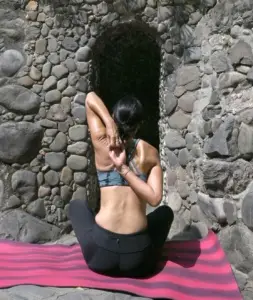
Statement of Need
Stroke survivors often face profound challenges during recovery, including physical disabilities, emotional distress, and reduced quality of life. Conventional rehabilitation approaches may overlook the holistic needs of stroke survivors, emphasizing physical recovery over mental and emotional well-being. There is a critical need for integrated health interventions that address the multifaceted aspects of stroke rehabilitation to improve overall outcomes and enhance quality of life.
Despite advances in medical treatment and rehabilitation protocols, stroke survivors often experience persistent physical impairments and psychological challenges that impact their daily lives. Integrative approaches, such as yoga therapy, offer promising avenues for enhancing recovery by addressing both physical rehabilitation and psychological well-being. However, these interventions require further research and validation to establish their efficacy and feasibility within clinical settings.
GoInwards seeks to bridge this gap by investigating the potential benefits of yoga therapy in stroke rehabilitation, aiming to:
This proposal outlines GoInwards’ commitment to advancing integrative health practices and addressing the holistic needs of stroke survivors through evidence-based research and community engagement.
Theory of Change Logic Model
This graph table provides a clear and structured representation of how yoga as a healing modality contributes to stroke rehabilitation, outlining the flow from inputs to impact through various stages of activities, outputs, and outcomes, aligned with the overarching goals and objectives.
| Components | Details |
| Goals | – Enhance overall quality of life for stroke survivors |
| – Promote holistic recovery through physical, emotional, and mental health improvement | |
| – Empower stroke survivors to lead active and fulfilling lives | |
| Objectives | – Increase flexibility, strength, and motor function |
| – Reduce stress, anxiety, and depression | |
| – Improve cognitive function and mental clarity | |
| – Encourage adherence to rehabilitation programs | |
| – Foster self-efficacy and confidence | |
| Inputs | – Trained yoga instructors |
| – Yoga mats and props | |
| – Accessible space for practice | |
| – Educational materials on stroke and yoga | |
| – Support from healthcare professionals | |
| Activities | – Conduct regular yoga sessions |
| – Provide personalized yoga routines | |
| – Incorporate breathing exercises | |
| – Integrate guided meditations | |
| – Offer educational workshops on lifestyle and wellness | |
| Outputs | – Number of yoga sessions conducted |
| – Attendance and participation rates | |
| – Distribution of educational materials | |
| – Engagement in breathing and meditation practices | |
| – Feedback from participants and healthcare providers | |
| Short-term Outcomes | – Increased flexibility and strength |
| – Enhanced relaxation and reduced stress | |
| – Improved breathing and respiratory function | |
| – Better emotional regulation | |
| – Increased awareness of body and mind connection | |
| Intermediate Outcomes | – Improved motor function and coordination |
| – Enhanced mental clarity and cognitive function | |
| – Reduced anxiety and depression symptoms | |
| – Increased adherence to rehabilitation programs | |
| – Strengthened self-efficacy and confidence | |
| Long-term Outcomes | – Enhanced overall quality of life |
| – Sustained physical and mental well-being | |
| – Decreased dependency on medication | |
| – Long-term integration of healthy lifestyle practices | |
| – Greater social engagement and support | |
| Impact | – Comprehensive recovery and rehabilitation post-stroke |
| – Holistic improvement in physical, emotional, and mental health | |
| – Empowerment of stroke survivors to lead active and fulfilling lives |
Proposed Program
The proposed yoga therapy program for stroke rehabilitation is designed to address the holistic needs of stroke survivors through evidence-based practices:
The program aims to empower participants in their recovery journey, fostering a supportive environment that enhances physical function, emotional resilience, and overall quality of life.
Sample Lesson Plan
| Practice | Physical Benefits | Emotional Benefits | Mental Benefits | Scientific Benefits | Muscles, Tissues, Organs, and Glands Engaged |
| Seated Forward Fold | Stretches spine and hamstrings | Enhances relaxation, reduces stress | Improves focus and mental clarity | Increases flexibility and circulation | Hamstrings, spine, lower back, parasympathetic nervous system |
| Gentle Seated Twist | Increases spinal flexibility, aids digestion | Relieves tension, promotes emotional balance | Enhances mental clarity, reduces anxiety | Enhances spinal mobility, aids in digestion | Spine, obliques, abdominal organs, intervertebral discs |
| Supported Bridge Pose | Strengthens back and glutes, improves circulation | Opens chest, promotes calmness | Enhances mental relaxation, reduces stress | Improves spinal health, opens chest cavity | Glutes, spine, chest, lungs, thyroid gland |
| Diaphragmatic Breathing | Improves lung capacity and oxygenation | Reduces stress, promotes relaxation | Enhances mental clarity and focus | Increases diaphragmatic efficiency, reduces hypertension | Diaphragm, lungs, heart, parasympathetic nervous system |
| Alternate Nostril Breathing | Balances nervous system | Promotes emotional balance, reduces anxiety | Enhances focus and mental clarity | Balances autonomic nervous system, improves respiratory function | Lungs, nasal passages, autonomic nervous system |
| Guided Imagery | Promotes physical relaxation | Reduces stress and anxiety | Enhances mental clarity and imagination | Reduces cortisol levels, enhances immune response | Brain, parasympathetic nervous system |
| Mindfulness Meditation | Encourages physical stillness and calm | Reduces stress, promotes emotional well-being | Improves focus, concentration, and mental clarity | Reduces stress-related symptoms, improves cognitive function | Brain, parasympathetic nervous system, prefrontal cortex |
This comprehensive table provides detailed insights into the benefits of each practice, highlighting their impact on physical, emotional, and mental health, supported by scientific findings and specifying the organs and glands engaged in each activity.
Implementation Plan
The implementation plan outlines key steps to ensure successful program delivery and participant engagement:
By establishing clear roles, responsibilities, and timelines, GoInwards aims to maximize program impact and promote a positive participant experience throughout the intervention period.
Management Plan
Effective project management is essential for coordinating program activities and achieving program goals:
Through proactive management and stakeholder engagement, GoInwards aims to maintain program integrity and responsiveness to participant needs throughout the implementation phase.
Evaluation Plan
The evaluation plan employs rigorous methods to assess the impact and effectiveness of the yoga therapy program:
By collecting robust data and employing rigorous analysis methods, GoInwards aims to generate evidence supporting the integration of yoga therapy into standard rehabilitation practices for stroke survivors.
Sustainability Plan
Ensuring the sustainability of the yoga therapy program involves strategic planning and partnership development:
Through diversified funding sources and strategic advocacy efforts, GoInwards aims to cultivate long-term partnerships and secure resources necessary for program sustainability and growth.
Partnership Table
GoInwards values collaborative partnerships with stakeholders committed to advancing integrative health and wellness:
By fostering strategic partnerships, GoInwards aims to leverage collective expertise and resources to enhance program impact and address community health needs effectively.
Mind Map Diagram
The mind map diagram visually represents the interconnected relationships and strategic alignment within GoInwards’ program ecosystem:
By visualizing program dynamics and interdependencies, the mind map diagram serves as a strategic tool for optimizing program operations and achieving sustainable outcomes.
Additional References
Research literature, systematic reviews, and evidence-based practices supporting the efficacy of yoga therapy in stroke rehabilitation:
This comprehensive proposal outlines GoInwards’ commitment to promoting holistic health through evidence-based yoga therapy, highlighting our dedication to enhancing the well-being of stroke survivors through innovative research, community engagement, and sustainable program development.

GoInwards is an IRS 501(c)(3) Non-Governmental Organization (NGO), chartered to advance wellness through integrative health related awareness, prevention, intervention, and resilience-based educational programs.
FEIN 90-0609802